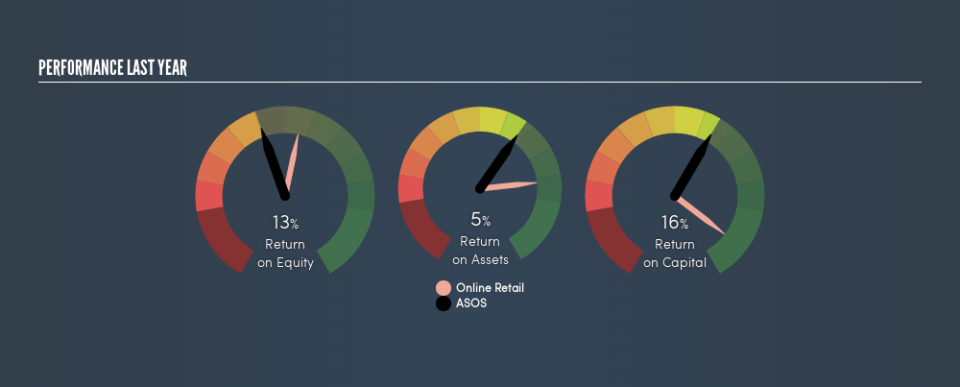Does ASOS Plc’s (LON:ASC) ROCE Reflect Well On The Business?

Today we are going to look at ASOS Plc (LON:ASC) to see whether it might be an attractive investment prospect. In particular, we'll consider its Return On Capital Employed (ROCE), as that can give us insight into how profitably the company is able to employ capital in its business.
First of all, we'll work out how to calculate ROCE. Next, we'll compare it to others in its industry. Last but not least, we'll look at what impact its current liabilities have on its ROCE.
Understanding Return On Capital Employed (ROCE)
ROCE measures the 'return' (pre-tax profit) a company generates from capital employed in its business. Generally speaking a higher ROCE is better. In brief, it is a useful tool, but it is not without drawbacks. Author Edwin Whiting says to be careful when comparing the ROCE of different businesses, since 'No two businesses are exactly alike.'
So, How Do We Calculate ROCE?
The formula for calculating the return on capital employed is:
Return on Capital Employed = Earnings Before Interest and Tax (EBIT) ÷ (Total Assets - Current Liabilities)
Or for ASOS:
0.16 = UK£77m ÷ (UK£1.1b - UK£651m) (Based on the trailing twelve months to February 2019.)
So, ASOS has an ROCE of 16%.
See our latest analysis for ASOS
Does ASOS Have A Good ROCE?
ROCE is commonly used for comparing the performance of similar businesses. It appears that ASOS's ROCE is fairly close to the Online Retail industry average of 19%. Independently of how ASOS compares to its industry, its ROCE in absolute terms appears decent, and the company may be worthy of closer investigation.
ASOS's current ROCE of 16% is lower than 3 years ago, when the company reported a 27% ROCE. This makes us wonder if the business is facing new challenges. The image below shows how ASOS's ROCE compares to its industry, and you can click it to see more detail on its past growth.
When considering this metric, keep in mind that it is backwards looking, and not necessarily predictive. Companies in cyclical industries can be difficult to understand using ROCE, as returns typically look high during boom times, and low during busts. ROCE is, after all, simply a snap shot of a single year. What happens in the future is pretty important for investors, so we have prepared a free report on analyst forecasts for ASOS.
How ASOS's Current Liabilities Impact Its ROCE
Current liabilities are short term bills and invoices that need to be paid in 12 months or less. Due to the way ROCE is calculated, a high level of current liabilities makes a company look as though it has less capital employed, and thus can (sometimes unfairly) boost the ROCE. To counter this, investors can check if a company has high current liabilities relative to total assets.
ASOS has total assets of UK£1.1b and current liabilities of UK£651m. As a result, its current liabilities are equal to approximately 57% of its total assets. This is admittedly a high level of current liabilities, improving ROCE substantially.
Our Take On ASOS's ROCE
This ROCE is pretty good, but remember that it would look less impressive with fewer current liabilities. There might be better investments than ASOS out there, but you will have to work hard to find them . These promising businesses with rapidly growing earnings might be right up your alley.
For those who like to find winning investments this free list of growing companies with recent insider purchasing, could be just the ticket.
We aim to bring you long-term focused research analysis driven by fundamental data. Note that our analysis may not factor in the latest price-sensitive company announcements or qualitative material.
If you spot an error that warrants correction, please contact the editor at editorial-team@simplywallst.com. This article by Simply Wall St is general in nature. It does not constitute a recommendation to buy or sell any stock, and does not take account of your objectives, or your financial situation. Simply Wall St has no position in the stocks mentioned. Thank you for reading.

 Yahoo Finance
Yahoo Finance 
